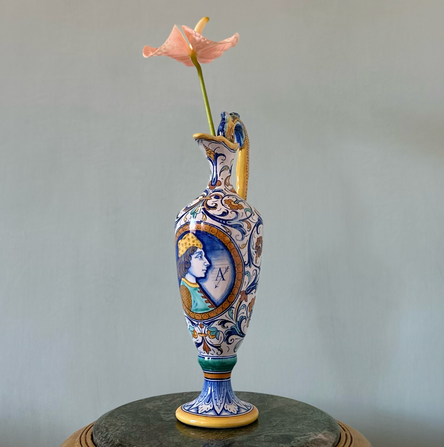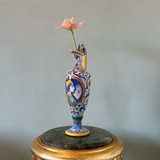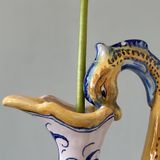Object 1
Not only art,
but history.
Deruta Vase with handle.
Hand-painted pottery, especially majolica, is never perfect. Too many variables. Most of the traditional Italian one requires two firings, one with which the so-called terracotta (terra: earth, cotta: cooked) is obtained, a second at a slightly lower temperature, which serves to ensure that the silicon, i.e. the glass contained in the enamel powder applied on the object of terracotta, melts and crystallizes forming a hard, shiny and waterproof surface capable of fixing the colors of the design. Between the first firing and the second, the glaze is applied (a 1-2 mm patina of dry powder that is still brittle) and the craftsman paints the piece with dyes derived from various elements or minerals, iron, manganese, cobalt and copper being the more widespread. The brushes used have a particular shape, because, especially those with a finer point, they have a "reservoir", i.e. a larger part at the base, capable of retaining water. In fact, the glaze patina is very hydrophilic, so a brush that is too thin would empty too quickly, not allowing you to finish a long line.
Painting majolica is difficult. It takes confidence, a long learning process, concentration. No mistakes are allowed because once a mark has been made it is really difficult to erase it without damaging it. Entering the order of ideas that no sign is wrong can help a lot, but it is also true that in this field beauty is a close relative of precision and an uncertain hand does not help. Then there are objects with a very particular shape that cannot be turned upside down during the decoration because this would damage the enamel (which, let's remember, is still hard powder…). In some parts these objects have to be painted with the brushes upside down, which is very difficult due to the laws of physics. In fact, water and the colors present in the brush are very little viscous and in the structure of the brush they always tend downwards, therefore sometimes not towards the surface to be painted but towards the opposite one. So much for the decorator.Then there are other variables that have to do with the temperatures of the oven, the homogeneity of the heat during cooking, the care with which the oven has been loaded (if two objects touch each other, both will have to be thrown away), the difference in temperature between first and second firing. The way an item was transferred to the kiln. Remember that once painted, it cannot be touched on the decorated part before firing; then try to imagine taking a jug like this one in the photo and putting it in an oven…I saw an object come out of the oven that a student, when it was still terracotta, had touched with his fingers after eating a salami sandwich during the school break. Obviously it was to be thrown away. I saw burnt green copper, bubbles everywhere, brushstrokes that had carried the white glaze with them, colors that had remained semi-raw, glazes poured everywhere.In short, a really interesting object, what is it? It's not the perfect object, no, it's the one where all these variables are under such incredible control that they give way to beauty. They are the ones where imperfection doesn't clash, where the mole tells you about a process, how the good craftsman has learned to fascinate the laws of nature and finally our eyes. Somehow, a miracle.



